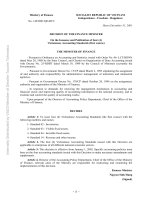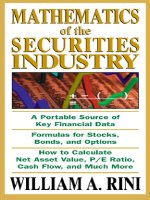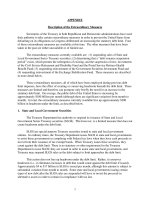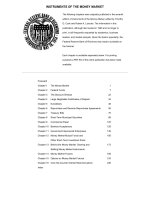Technical Analysis of the Financial Markets_1 pdf
Bạn đang xem bản rút gọn của tài liệu. Xem và tải ngay bản đầy đủ của tài liệu tại đây (321.36 KB, 18 trang )
The Stock Market
Advisory Board
Alan L. Carsrud
Professor of Industrial and Systems Engineering, Clinical Professor of
Management, and Executive Director of the Eugenio Pino and Family
Global Entrepreneurship Center, Florida International University
Alan Reynolds
Senior Fellow
Cato Institute
Wesley B. Truitt
Chairman and Series Editor
Adjunct Professor
Anderson Graduate School of Management
University of California, Los Angeles
Walter E. Williams
John M. Olin Distinguished Professor of Economics
George Mason University
Charles Wolf Jr.
Senior Economic Advisor and Corporate Fellow in International Economics
The RAND Corporation
The Stock
Market
RIK W. HAFER AND
SCOTT E. HEIN
GREENWOOD GUIDES TO BUSINESS AND ECONOMICS
Wesley B. Truitt, Series Editor
GREENWOOD PRESS
W
ESTPORT,CONNECTICUT
LONDON
Library of Congress Cataloging-in-Publication Data
Hafer, R. W. (Rik W.)
The stock market / Rik W. Hafer and Scott E. Hein.
p. cm. — (Greenwood guides to business and economics,
ISSN 1559–2367)
Includes bibliographical references and index.
ISBN 0–313–33824–8 (alk. paper)
1. Stock exchanges. 2. Stock exchanges—United States. I. Hein,
Scott E., 1949– II. Title.
HG4551.H23 2007
332.64'2—dc22 2006029484
British Library Cataloguing-in-Publication Data is available.
Copyright # 2007 by Rik W. Hafer and Scott E. Hein
All rights reserved. No portion of this book may be
reproduced, by any process or technique, without the
express written consent of the publisher.
Library of Congress Catalog Card Number: 2006029484
ISBN: 0–313–33824–8
ISSN: 1559–2367
First published in 2007
Greenwood Press, 88 Post Road West, Westport, CT 06881
An imprint of Greenwood Publishing Group, Inc.
www.greenwood.com
Printed in the United States of America
The paper used in this book complies with the
Permanent Paper Standard issued by the National
Information Standards Organization (Z39.48–1984).
10987654321
To
Gail and Cait
Ellen, Tracey, and Jocelyn
Contents
Illustrations ix
Series Foreword by Wesley B. Truitt xi
Preface and Acknowledgments xv
Chronology xvii
1. Introduction 1
2. A Brief History of the U.S. Stock Market 9
3. Stocks in Today’s Economy 37
4. Today’s Stock Market in Action 55
5. Recent Innovations in Stocks and Stock Markets 69
6. Regulation of the Stock Market 85
7. Stock Markets Abroad 101
8. Summing It Up 119
Appendix: Companies Listed in the Dow Jones Industrial Average 123
Glossary 127
Bibliography and Online Resources 133
Index 137
Illustrations
FIGURES
1.1 Dow Jones Industrial Average: Close, 1950–2006 6
2.1 Dow Jones Industrial Average: Close, 1900–1910 15
2.2 Dow Jones Industrial Average: Close, 1910–1935 19
2.3 Dow Jones Industrial Average: Close, 1980–1990 24
2.4 Dow Jones Industrial Average: Close, 1990–2005 30
7.1 Dow-Nikkei-FTSE and Adjusted Dow-Nikkei-FTSE,
1989–2005 113
7.2 Economic Growth before and after an Exchange
Is Opened 116
TABLE
7.1 Exchanges Ranked by Market Capitalization
in U.S. Dollars, End of 2004 102
Series Foreword
Scanning the pages of the newspaper on any given day, you’ll find headlines
like these:
‘‘OPEC Points to Supply Chains as Cause of Price Hikes’’
‘‘Business Groups Warn of Danger of Takeover Proposals’’
‘‘U.S. Durable Goods Orders Jump 3.3%’’
‘‘Dollar Hits Two-Year High Versus Yen’’
‘‘Credibility of WTO at Stake in Trade Talks’’
‘‘U.S. GDP Growth Slows While Fed Fears Inflation Growth’’
If this seems like gibberish to you, then you are in good company. To most
people, the language of economics is mysterious, intimidating, impenetrable.
But with economic forces profoundly influencing our daily lives, being fa-
miliar with the ideas and principles of business and economics is vital to our
welfare. From fluctuating interest rates to rising gasoline prices to corporate
misconduct to the vicissitudes of the stock market to the rippling effects of
protests and strikes overseas or natural disasters closer to home, ‘‘the econ-
omy’’ is not an abstraction. As Robert Duvall, president and CEO of the
National Council on Economic Education, has forcefully argued, ‘‘Young
people in our country need to know that economic education is not an option.
Economic literacy is a vital skill, just as vital as reading literacy.’’
1
Under-
standing economics is a skill that will help you interpret current events that are
playing out on a global scale, or in your checkbook, ultimately helping you
make wiser choices about how you manage your financial resources—today
and tomorrow.
It is the goal of this series, Greenwood Guides to Business and Economics,
to promote economic literacy and improve economic decision-making. All
seven books in the series are written for the general reader, high school and
college student, or the business manager, entrepreneur, or graduate student in
business and economics looking for a handy refresher. They have been
written by experts in their respective fields for nonexpert readers. The ap-
proach throughout is at a ‘‘basic’’ level to maximize understanding and de-
mystify how our business-driven economy really works.
Each book in the series is an essential guide to the topic of that volume,
providing an introduction to its respective subject area. The series as a whole
constitutes a library of information, up-to-date data, definitions of terms,
and resources, covering all aspects of economic activity. Volumes feature
such elements as timelines, glossaries, and examples and illustrations that
bring the concepts to life and present them in a historical and cultural context.
The selection of the seven titles and their authors has been the work of an
Editorial Advisory Board, whose members are the following: Alan Carsrud,
Florida International University; Alan Reynolds, Cato Institute; Robert
Spich, University of California, Los Angeles; Wesley Truitt, Loyola Mary-
mount University; Walter E. Williams, George Mason University; and
Charles Wolf, Jr., RAND Corporation.
As series editor, I served as chairman of the Editorial Advisory Board
and want to express my appreciation to each of these distinguished in-
dividuals for their dedicated service in helping to bring this important series
to reality.
The seven volumes in the series are as follows:
The Corporation by Wesley B. Truitt, Loyola Marymount University
Entrepreneurship by Alan L. Carsrud, Florida International University, and
Malin Bra
¨
nnback, A
˚
bo Akademi University
Globalization by Robert Spich, Christopher Thornberg, and Jeany Zhao, UCLA
Income and Wealth by Alan Reynolds, Cato Institute
Money by Mark F. Dobeck and Euel Elliott, University of Texas at Dallas
The National Economy by Bradley A. Hansen, University of Mary Washington
The Stock Market by Rik W. Hafer, Southern Illinois University–Edwardsville,
and Scott E. Hein, Texas Tech University
Special thanks to our senior editor at Greenwood, Nick Philipson, for
conceiving the idea of the series and for sponsoring it within Greenwood
Press.
xii Series Foreword
The overriding purpose of each of these books and the series as a whole is,
as Walter Williams so aptly put it, to ‘‘push back the frontiers of ignorance.’’
Wesley B. Truitt, Series Editor
NOTE
1. Quoted in Gary H. Stern, ‘‘Do We Know Enough about Economics?’’ The
Region, Federal Reserve Bank of Minneapolis (December 1998).
Series Foreword xiii
Preface and Acknowledgments
Readers familiar with the complexities of the stock market may be struck by
the brevity of this book. Our goal is not to cover the entire landscape en-
compassing the stock market and its related areas. What the book does ac-
complish is to give you a glimpse into the many-faceted subject of stocks and
financial markets. With this in mind, the treatment is not exhaustive but, we
trust, inclusive enough to provide an overview of the stock market: how it
began, how it functions, and some of the instruments traded, from common
to arcane. Although the focus is primarily on the U.S. stock market, given the
increasingly interrelated nature of financial markets, there is some discussion
of the development of foreign stock exchanges and how their formation may
be related to economic development.
Today’s stock market, both here and abroad, represents the culmination of
a long development in financial assets and the procedures by which they are
traded. While early markets traded shares of stocks in companies, something
that continues to this day, modern stock exchanges allow for the trading of
many more sophisticated assets. Options, other derivatives, and the like are
all part of the market’s offering. And as the sophistication of assets traded has
increased, so have the methods by which they are traded. From the early days
when the introduction of the telegraph and telephone connected investors
across the country with the exchanges, modern technology in the form of
electronic trading, such as the National Association of Securities Dealers
Automated Quotation (NASDAQ) exchange, is predictably crowding out
the quaint, though antiquated, face-to-face kind of trading. And such tech-
nology means more efficient and speedy flows of information. Consequently,
modern traders can watch, in real time, the value of their stocks change on
their laptop computers.
Such flow of information creates problems for regulating the market.
Regulations passed in past decades are made obsolete by new technologies
and new products. The age-old debate whether regulation helps or hinders
markets allocate financial capital continues, but there is some evidence that
unbridled trading can lead to undesirable consequences. For many, the stock
market crashes of 1929, 1987, and the meltdown that began in 2000 are
evidence that some regulation may be optimal. Without trying to solve the
debate, the notion of why stock markets are regulated and how key regula-
tions developed are covered.
In trying to cover the topic, it is necessary to use a language that may seem
arcane. Like any other topic, there are terms specific to finance and economics
and stock markets. Such language will creep into the discussion, hopefully
only when necessary. At all times, however, the goal is to present the material
in a manner that is accessible to the general reader. If we are successful, this
book will not be the last book on the topic you pick up.
A number of people helped us bring this book into existence. We would
like to thank Nick Philipson, Senior editor for Business/Economics at
Greenwood Publishing Group, and Wesley Truitt, editor of this series, for
involving us with this project and providing encouragement, comments, and
assistance along the way. We also thank David Amable for his help in
searching out data and Stephanie Leskovisek, Janet Novosad, and Shelby
Otta for getting our rough drafts into more readable form. Tracey Griffith
read and commented on much of the book in earlier drafts and she expertly
compiled the glossary that accompanies the book. For this, we owe her a
special debt of gratitude. We also would like to acknowledge the benefits we
have gained from many teachers and colleagues, too many to name in-
dividually, who helped in our understanding of the stock market. Finally, we
especially thank our wives Gail and Ellen and all of our children, first for their
inspiration, and second for their forbearance through the project. We hope
that they approve of the results.
xvi Preface and Acknowledgments
Chronology
1682 Exchange Rules and Regulation enacted in Frankfurt,
Germany, officially establishing the stock exchange.
1790 Federal government refinances Revolutionary War debt. This
includes both federal and state debt, totaling almost $80
million in bonds. The first significant issue of publicly traded
securities.
1792 The Buttonwood Agreement is signed on May 17 marking
the beginning of the organized securities trading in what
would become the New York Stock Exchange (NYSE). The
Bank of New York is the first company listed.
1801 After a century of unregulated trading, the London Stock
Exchange is officially created.
1817 The New York Stock & Exchange Board (NYS&EB) is
created and locates at 40 Wall Street.
1835 A fire destroys over 700 buildings in lower Manhattan forcing
the NYS&EB to relocate to temporary headquarters.
1844 The invention and use of the telegraph allows brokers and
investors outside of New York City to communicate with the
stock exchange.
1851 Amsterdam Stock Exchange Association forms to regulate
share trading in the Amsterdam exchange, one of the world’s
oldest.









